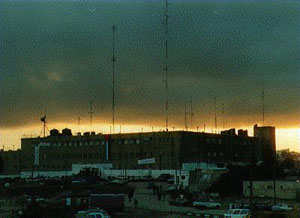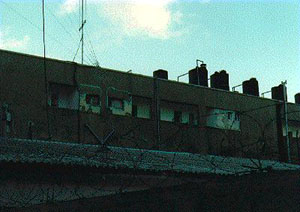
Our first stop was the former Israeli military headquarters, vacated at 6:00am this morning, and handed over to the Palestinian police.
When the Mukhabarat ("Intellegence") entered it, they found that the best offices and accomodation had already been occupied by the Amin al-Waqai'i ("Preventative Security"), one of the many Palestinian security organs in the West Bank, revealing an interesting level of coordination between the Israelis and Jibril Rajoub, its head.
The Amara building, as it is known, is Hebron's counterpart to Ramallah's Muqata'a, the subject of several previous diary entries.

The usual obsequious welcome banners from various organisations were draped over the Amara. This one, from the Hebron Branch of the General Union of Palestinian Workers, says:
"One people, one leadership, behind the Palestine Liberation Organisation and the Palestinian National Authority. Hand in hand, towards Holy Jerusalem, the capital of the independent Palestinian State."
The new Palestinian Authority headquarters, looking remarkably like the Ramallah one, made me wonder if the same kinds of things we saw in Ramallah would take place here.
People detained without charge or trial for long periods of time, the same small mindedness that brought the PA to make it a criminal offence to be caught eating, drinking or smoking in public during Ramadan.
Of course the same things will happen.

Adli, Kifah and I went for a tour inside the building. For Adli, this was more than just curiosity. He himself had been detained in this building by the Israelis on 8 occasions, sometimes just while waiting to be transferred, called "the post office". The gloomy block pictured left was the scene of one of his interrogations.
Adli was arrested on 31 March 1988. Handcuffed, he was beaten for 3 hours. Two Israeli soldiers, Faris and Adeeb (Interrogators often take Arabic names), dragged him by his hair to one of the windows on the left flush with the wall, and made him look out, down at the prisoners below. "Look manyak ("fucker")," they said, "we are going to make sure you spend a long time there."
After five days of interrogation, he was shipped off to Ketsiot prison in the Negev desert, called Ansar 3 by the Palestinians and nicknamed "The camp of slow death". He spent six months there in administrative detention (no charge or trial) before being released.
How did Adli feel, seeing the cellblocks deserted and the Israelis gone, I asked him? He paused. "I guess it's a good feeling," he said. "It's not how I imagined it. It was always mysterious when you were a prisoner. Visiting the place now and seeing all the empty rooms, it could be any old building. The psychological dimensions of the place that you experienced as a prisoner are not here anymore. You can't imagine what it was like. Once I was in here for torture, now I am in here for tourism."
As we explored the various rooms, we found one cell in the depths of the building. Ten feet square, it was the lowest point of the building, a dank, basement cell. It had no windows, making it pitch black. We shivered as we looked around it with cigarette lighters, imagining what went on down here. And what might go on here under the Palestinian Authority.